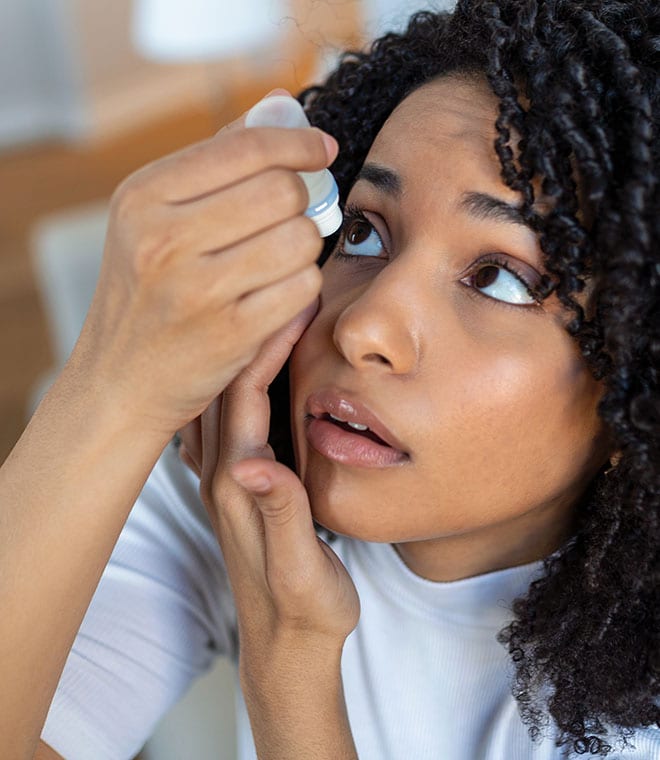Health
Pink eye (conjunctivitis): Symptoms, causes and treatment
By Dennis Galvon, MD Feb 29, 2024 • 8 min
Every year, around 6 million adults and children in the U.S. develop conjunctivitis, commonly called pink eye. It’s important to understand the causes and symptoms of this condition, so that you know what to look for and can seek treatment when issues arise.
What is pink eye?
Pink eye is inflammation of the conjunctiva, a thin, clear membrane that lines the inside of your eyelid and covers the outside of your eyeball. Its job is to help keep your eyes moist.
What are symptoms of pink eye?
Symptoms of pink eye include:
- Redness of the white of the eye
- Redness along the inside of the eyelid
- Thick yellow, green or white discharge from the eye
- Waking up with a thick yellow crust in the eyelashes and/or around the eye
- Feeling of grittiness or something stuck in the eye
- Itching and/or burning of the eye
- Blurry vision
Pink eye symptoms can affect one or both eyes.
What causes pink eye?
Pink eye can be caused by a number of different factors, including:
1. Viruses: The most common cause of pink eye, viruses are infectious microbes that can be spread from person to person. Adenoviruses, the common cold virus and COVID-19 are examples of viruses that can cause pink eye.
Viral pink eye is highly contagious. In most cases, viral pink eye involves both eyes and is accompanied by other symptoms, like coughing, runny nose and headaches.
2. Bacteria: Small single-celled organisms called bacteria can be found throughout the environment. Common bacteria, such as Staphylococcus aureus, Streptococcus pneumoniae, Haemophilus influenzae and Moraxella catarrhalis can cause a pink eye infection if they enter an eye. In some cases, the infection may spread to the second eye.
Bacterial pink eye occurs more often in children than adults. The condition is contagious, and it can spread through families, schools and child care centers. Although bacterial pink eye infections occur throughout the year, they’re most common from December through April.
3. Allergies: Allergic reactions occur when the body mistakes a protein called an allergen for a threat and launches an immune response. Coming into contact with an allergen that you’re sensitive to can trigger pink eye symptoms. Some common allergens include pet dander, pollen, dust mites and molds.
Unlike bacterial and viral infections, allergic pink eye isn’t contagious. It may occur with other allergy symptoms, like sneezing and nasal congestion.
4. Irritants: Eye irritation can result in pink eye. Some potential sources of irritation include:
- Smoke
- Chlorine
- Chemicals in shampoos and cosmetics
- Foreign objects that get stuck in the eye
- Contact lenses, especially when they’re worn for too long or they’re not cleaned properly
5. Medical conditions: In some cases, pink eye can occur due to an underlying medical condition, such as certain autoimmune disorders. Sexually transmitted infections (STIs), like herpes simplex and gonorrhea, can cause pink eye in adults, and babies born to mothers with these STIs may also develop symptoms of conjunctivitis. Blocked tear ducts in infants can give rise to pink eye as well.
What is the treatment for conjunctivitis?
Your healthcare provider can evaluate and treat most cases of pink eye. Treatment for pink eye varies based on the cause of symptoms as follows:
- Viral pink eye: In many cases, no treatment is necessary for viral pink eye, as symptoms typically clear up on their own once the infection has run its course. In rare cases, healthcare providers may need to prescribe antiviral medications for pink eye caused by the herpes simplex virus, varicella-zoster viruses and certain STIs.
- Bacterial conjunctivitis: When bacteria is the cause of pink eye, healthcare providers usually prescribe antibiotic eye drops or ointment. In some cases, an oral antibiotic may be prescribed in conjunction with or in lieu of topical medications.
- Allergic conjunctivitis: Antihistamine eye drops are the most common treatment for pink eye associated with allergies. Available over the counter, the eye drops contain medications that fight histamine, the immune system chemical that triggers inflammation when you come in contact with an allergen. Prescription-strength antihistamine eye drops may be prescribed for severe cases of pink eye.
If pink eye recurs frequently, your healthcare provider may recommend additional treatments for allergies, such as over-the-counter oral antihistamine medications, prescription oral medications for allergies or immunotherapy (allergy shots).
- Irritant-associated pink eye: In cases where an irritant is responsible for pink eye, flushing the eye out thoroughly with water is usually the first step in treatment. In many cases, further intervention isn’t necessary, and the irritation typically resolves on its own.
How long does conjunctivitis last?
Pink eye typically resolves within several days, but it can take longer. Antibiotics should clear bacterial conjunctivitis more quickly. However, some viral infections may persist for two to three weeks.
While you recover from pink eye, your healthcare provider may advise you to apply cold or hot compresses to your eye area in order to relieve discomfort.
You’ll also typically need to discontinue wearing contact lenses and wear glasses instead until your symptoms subside. If you have viral or bacterial pink eye, your healthcare provider will likely tell you to replace your lenses with a fresh pair when it’s time to resume wearing contacts.
Can you prevent pink eye?
Pink eye isn’t completely preventable, but there are things you can do to reduce your risk of developing or spreading viral and bacterial infections. Consider the following pink eye prevention tips:
- Avoid touching and rubbing your eyes
- Wash your hands with soap and water frequently
- Clean discharge around your eyes at least twice per day
- Wash your hands before and after you apply eye drops or ointment
- Don’t share personal items, such as towels, cosmetics and cups
- Follow your healthcare provider’s instructions regarding the handling and cleaning of your contact lenses
- Wash towels, bed linens and washcloths frequently
- Clean your eyeglasses regularly
If you develop symptoms of pink eye, see your healthcare provider. They can evaluate your symptoms and recommend treatment, if necessary.
Published February 2024.
References:
- https://www.mayoclinic.org/diseases-conditions/allergies/symptoms-causes/syc-20351497
- https://www.genome.gov/genetics-glossary/Bacteria
- https://my.clevelandclinic.org/health/diseases/8614-pink-eye
- https://www.mayoclinic.org/diseases-conditions/pink-eye/symptoms-causes/syc-20376355
- https://www.cdc.gov/conjunctivitis/index.html
- https://www.nei.nih.gov/learn-about-eye-health/eye-conditions-and-diseases/pink-eye
- https://www.genome.gov/genetics-glossary/Virus
- https://www.merckmanuals.com/professional/eye-disorders/conjunctival-and-scleral-disorders/viral-conjunctivitis
- https://www.mayoclinic.org/diseases-conditions/allergies/diagnosis-treatment/drc-20351503



-symptoms-and-seasonal-allergies/CH_Difference_COVID_Allergies_330x380.jpg)
